
Title: Wupatki Ruins Trail
Wupatki National Monument, Arizona

WUPATKI NATIONAL MONUMENT
15 CENTS IF YOU TAKE THIS BOOKLET HOME
21st EDITION—4-76—14M

South portion of Wupatki before excavation.
Wupatki National Monument is one of 299 areas (as of 1974) administered by the National Park Service, U. S. Department of the Interior. These include such magnificent scenic areas as Grand Canyon and Yosemite National Parks, and other Parks and Monuments set aside for outstanding scenic, scientific, and historical values.
The National Park Service has the responsibility of preserving the Parks and Monuments in their natural, unspoiled condition and of making them available for your enjoyment in such manner as to leave them unimpaired for the enjoyment and inspiration of future generations. To achieve this high purpose such destructive activities as woodcutting, hunting, grazing, mining and even flower-picking are prohibited. We hope you will join with us in protecting Wupatki National Monument by taking only pictures and inspiration and leaving only footprints and good will.
The uniformed employees of the National Park Service are here to serve you and will welcome the opportunity to make your stay in Wupatki more enjoyable.
KEEP AMERICA BEAUTIFUL
This booklet is intended to supplement the free leaflet which gives the general story of Wupatki National Monument. It might be useful to read that leaflet before going through the ruin itself. We would appreciate it if you would sign the register.
The trail will lead you around Wupatki Ruin. Numbered stakes on the trail correspond to numbered paragraphs in this booklet, which will help you understand the features you will see.
Spend as much time in the ruin as you like; all we ask is your cooperation in keeping off the walls and not removing pottery fragments, rocks, plants, or other material from the area. Thank you. PLEASE STAY ON TRAIL!
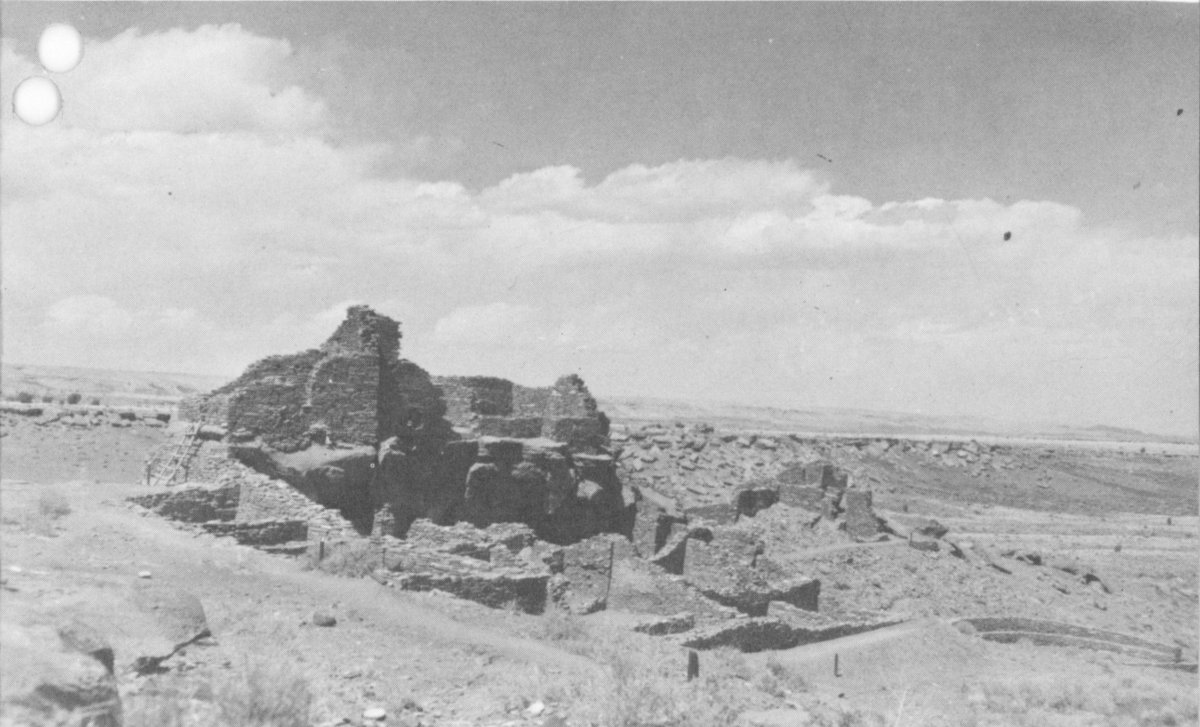
Wupatki Ruin with “amphitheater” in lower right.
From this point is an excellent view of the entire ruin, including the “amphitheater” and ballcourt. At its peak of occupation, during the 1100’s, the village contained over 100 rooms with 250-300 inhabitants. It is the largest of more than 800 ruins within the boundaries of Wupatki National Monument, and was partially excavated 2 in 1933-34 by the Museum of Northern Arizona, and the National Park Service in 1941-42 and 1952-53.

Wupatki Ruin, after excavation and some restoration in the 1930’s.
This dwelling was occupied from about A.D. 1120 to A.D. 1210 by the Sinagua (see-NAH-wah) Indians, and this region represents the northernmost limits of occupation by this prehistoric tribe. The Little Colorado River, seven miles east (11km), roughly marks the boundary between this group and another prehistoric tribe to the north, the Anasazi (ah-nah-sah-zee). Other Sinagua lived to the south in the Verde Valley.
Above is a picture of Wupatki Ruin as it appeared after excavation and partial restoration under the CWA program in the 1930’s. Since then the National Park Service has developed a policy to preserve rather than restore archeological structures. For this reason, the restored portions were removed. We believe the ruin as it appears today leaves one with a greater feeling of admiration for the prehistoric builders than it would with any added restoration.
(Ephedra viridis). A valuable browse plant for grazing animals in winter, 3 when better forage is lacking. A palatable tonic beverage can be made from the dried stems and flowers of the plant, and it was used by Indians and early white settlers in the treatment of certain diseases. Ephedrine is obtained from a Chinese species.
Notice how this rock breaks down into good building stones. The banded layers of sandstone, developed as silt in an ancient shallow sea, split along horizontal planes, and for this reason it was easily quarried and used by the Indians in construction of their dwellings.
The gray material on the sandstone is a lichen (ly-ken) which produces an acid that assists in the breakdown of rock, the first step in producing soil.
(Atriplex canescens). One of the most common shrubs of the Southwest, adapted to diverse soils and climatic conditions, it is a valuable browse plant. Indians used to depend on saltbushes as a source of meal which was made from the parched seeds, and like pinole (made from mesquite pods) it sometimes was mixed with water to make a beverage.
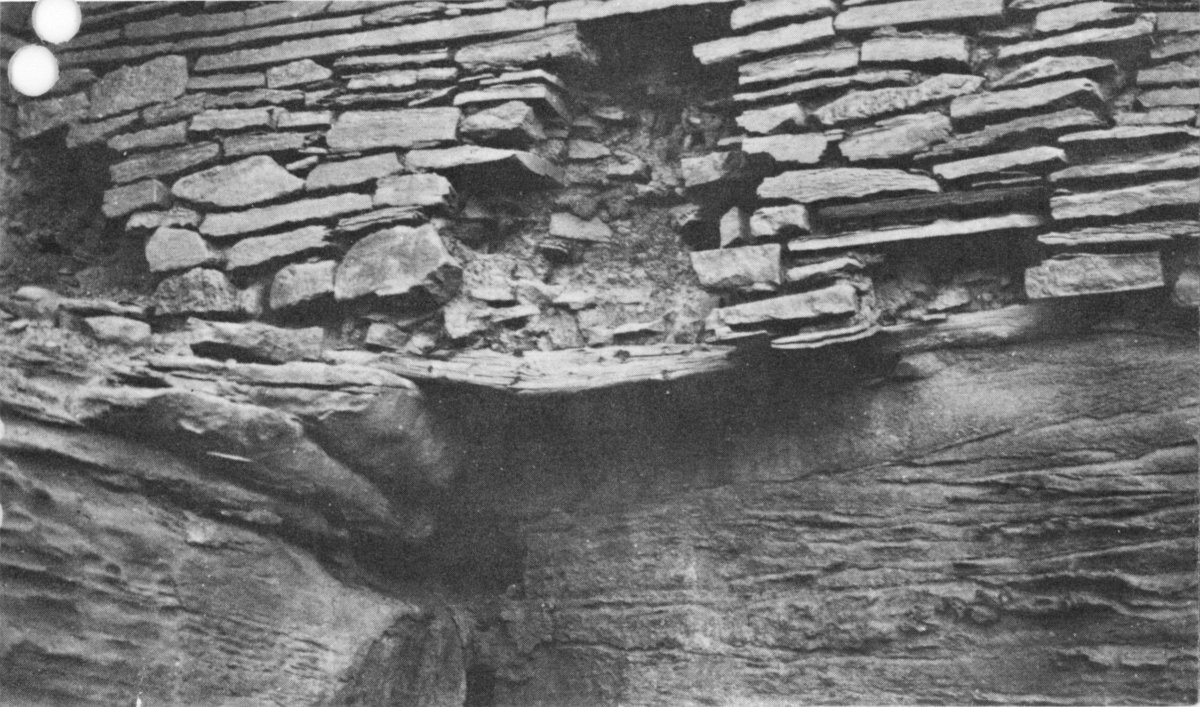
Pole-supported wall before repair, above you at Stake 5.
here is four stories high at its tallest point—two stories against the rock and two stories above. To the rear 4 of the iron beam, necessary to support the upper walls, you can see one of the original timbers used in construction of this dwelling.

The “amphitheater”
Notice the small opening in the wall above the stone-lined trench. With the trench below, it was used to conduct air to the interior rooms of the structure. As the dwelling was extended toward you from the higher portions, the added outside rooms blocked air from the older ones, necessitating a series of vents to take fresh air to the interior rooms.
The small rooms you see were used for storage of corn and beans, or other food products.
with a small storage bin in the rear. The metate (meh-TAH-tay) and mano (mah-no) in the background were used by the Indians to grind corn. Often two or three metates, with manos for each, are found in one room. This does not mean the room was used for grinding purposes only. As is often the case today among Pueblo Indians, the three metates are all made from rocks with different degrees of coarseness. Coarse metates were used for preliminary grinding and fine-grained ones for final grinding.
Centered in the floor of this room is a small, rectangular, stone-lined firepit which was used for both heating and cooking.
The long stone-lined channel, as at Stake No. 5, was used as a ventilator, the opening being at floor level in the cliff wall to your right. The upright slab of stone at the end of the ventilator trench deflected the incoming air so that the draft would not pass directly across the firepit, which was usually situated in the center of the room or work area.
This means of ventilation was not generally used by the Sinagua Indians, having been adopted from the neighboring Anasazi, with whom they had very close contact in this area.
From this vantage point is a good view of the “amphitheater” or “dance plaza.” This circular depression resembles in many ways the large ceremonial structures (kivas) of the neighboring Anasazi. There is no indication that it was ever roofed, and the ceremonial features normally found in a kiva are lacking. For this reason there is doubt as to the exact functions of this structure, which is unique within the Sinagua culture area.
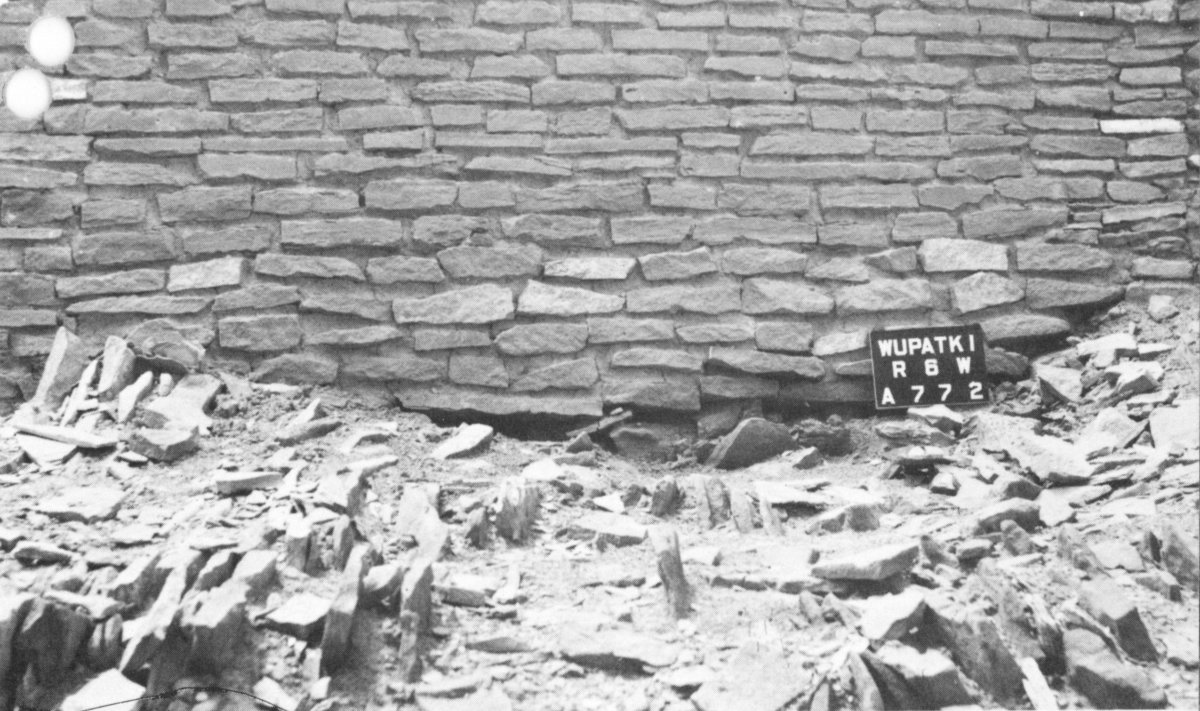
In the foreground is a collapsed wall that fell intact.
This is how the ruin looked prior to excavation. As you pass through this section of rubble notice how large sections of the walls fell intact, with individual stones still retaining their original relative positions. The walls were probably two stories high at this point.
Archeologists uncovered a quantity of material by carefully excavating such rubble as this. The more fragile material on the floor, such as pottery, was in most cases crushed or scattered by falling rocks when the ceilings or walls collapsed. Because the excavators saved all fragments of pottery resting on the floor, they were able to restore many of the broken vessels, some of which exhibit beautiful designs in black on a white background.
You will see bins on the upper right which were used for storage. The doorway to the rear is not prehistoric, the room having been remodeled and occupied by a sheepherder about 1880.
Looking down about 150 yards (137m) you will see an oval masonry ring. This is a ball court, one of several in this area, the northernmost ones that have been discovered. In southern Arizona and all through Mexico and Central America ball courts are fairly common.
We know very little about the game that was played in this court. However, in Arizona sites two rubber balls have been found which are similar to those seen in use in the Mexican ball courts by the Spanish conquerors when they first entered Mexico. The game played here, if like those in Mexico, was part of religious ritual.
This ball court is unique among Arizona ball courts for it is constructed of masonry. Others are generally made of adobe.
Take the marked trail to the ball court for a closer look if you wish.
to the pueblo the builders joined their walls to ones already existing, as can be seen on your left. 7 As a result of constructing rooms in this fashion the builders were unable to interlock building stones of the new room with those of the old one. It was usually at these points that walls collapsed first, because they were not adequately tied together.

Unbonded walls more often collapsed.
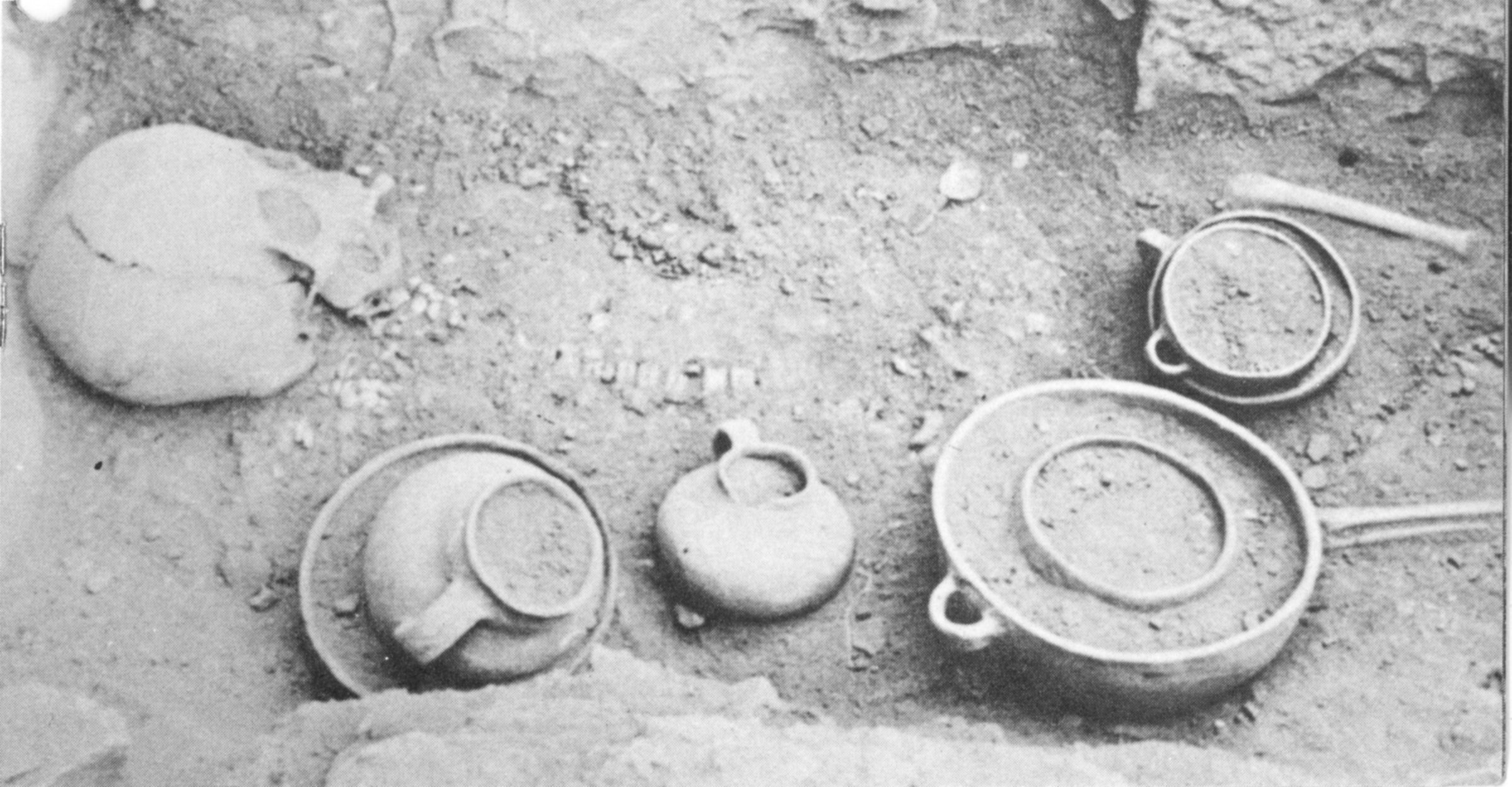
One of the seven infant burials mentioned at Stake 12.
In this room seven infant burials were found in slab-lined pits (only one pit can be seen today). As with most people, the Indians held a close relationship to their children, probably believing, like the Hopi today, that the spirit of the 8 dead child would be reborn in the next baby. Consequently the deceased were often buried in the mother’s house.

Collapsed roof.
The area in front of you was an outdoor workshop, or patio, where the people could grind corn, make pottery, mend clothes, gamble, or gossip. It was surrounded by a low “windbreak” wall and perhaps in the summer was partially covered by a brush “shade.”
Upon entering this room one can see how the original builders took advantage of two natural rock walls. This eliminated construction of two sides of the room. The lower portion was filled 5 feet (1.5m) deep with trash before the first floor was laid.
Original timbers are still in place above the opening in the rear wall. Holes for beams that supported the second story are visible in the side walls. A considerable number 9 of beams was recovered during the excavations at Wupatki, and the study of this material has contributed greatly to the tree-ring method of dating in the Southwestern region.
Most of these beams were of ponderosa pine, not present nearby. It is possible the pine forest was closer to Wupatki then than now.
The sloping ground all along this side of the ruin is the rubbish heap. It is from trash deposits such as these that archeologists are able to obtain a great deal of information about material developments and changes that occurred in the history of the people who lived in these villages.
Many interesting specimens have been recovered from trash deposits and rooms of Wupatki, such as fragments of cloth woven in different patterns or colored with a blue dye, brightly painted baskets, ornaments of red siltstone and shell, small copper bells, parrot burials, and several macaw burials, to mention a few. Many of these items were traded in to this region from the south, some having come from Mexico, such as the macaws and copper bell.

Room with firepit with a deflector between it and ventilator in wall.
The two beams at the rear are original roof beams that have been in the ruin almost 10 800 years. Above the beams once lay the cross pieces forming the next layer, on top of which was placed the mud or clay to complete the roof.
The bins below the beams were used for storage of farm products and other foods gathered from wild plants.
The T-shaped doorway through which you entered is quite common in Southwestern ruins. One probable reason for this shape was that in the winter a blanket, a skin, or a mat could be hung over the larger opening, leaving the lower, smaller one free to admit fresh air.
have been excavated. They were originally covered by a dirt roof at about the height of a man. The entrance to these rooms, as well as all other ground floor rooms in the pueblo, was through a hatchway in the roof, which also served as an escape for the smoke from the firepit.
In the end room is another example of a ventilator opening going through the wall, and a vertical slab (deflector) placed to keep the draft of fresh air from blowing firepit sparks around the room.
This is the last stop on the trail. On your way back, please return this booklet, or, you may purchase it for 15 cents.
EVERY LITTER BIT HURTS
Sunset Crater, 18 miles (29km) south of here, is the youngest of 400 volcanoes located in the Flagstaff region. It is one of the few prehistoric volcanoes in the world that we can accurately date, (another being Mt. Mazama, where now is Crater Lake, Oregon), and one of the few that had such a profound effect upon people living in the area. When it erupted it covered almost 800 square miles, (2080km²) including the Wupatki area, with fine, black volcanic ash. This eruption took place before the masonry pueblos in this region were built.
When the eruption was over, a few individuals probably 11 returned to this area and found, much to their surprise and pleasure, that they could grow crops in locations where they hadn’t been able to farm before. The layer of volcanic ash acted as a moisture-retaining mulch; the people could plant their seeds in the underlying soil and the cinder cover would hold enough moisture to insure them a good harvest.
When this word spread around, it created a great land rush, the only one we know of in the Southwest. Large numbers of Indians from all over this part of the Southwest swarmed into the region of the cinder fall to take advantage of new farming land. The Hohokam came from the south, the Mogollon from the southeast and the Anasazi from the north.
The main concentration took place between A.D. 1100 and 1200, and during that time the area between the San Francisco Mountains and the Little Colorado River was inhabited by perhaps 8,000 Indians.

Citadel Ruin
Abandonment of the area is almost as interesting as the occupation. Tree-ring evidence indicates that from about A.D. 1215 to 1300 there was a long drought of varying intensity which culminated in the great drought of 1276-1299. 12 Winds accompanying the drought turned the area into a dust bowl, moving away the moisture-retaining cover of cinders on which the people had depended for their farming. Depopulation set in as farming acreage decreased.
The Anasazi element apparently moved north or east into the Tsegi Canyon or Hopi country, while the Sinagua moved south into the Verde Valley and east to the Chavez Pass region near Winslow. By the mid 1200’s Wupatki probably was completely abandoned.
When the Spanish came through this general region between 1583 and 1605, they encountered small bands of Indians in the San Francisco Mountains near Flagstaff. These probably were hunting and gathering parties of either Havasupais from the Grand Canyon or Yavapais from the Verde Valley. No Indians were reported between the Hopi villages and the San Francisco Mountains. The Navajo, who are seen in the monument today, did not move into the general Wupatki region until about 1870.
Other accessible ruins in the monument are Wukoki, a three-story pueblo built on a large outcrop of sandstone, Lomaki, and Citadel Ruin.

Wukoki Ruin
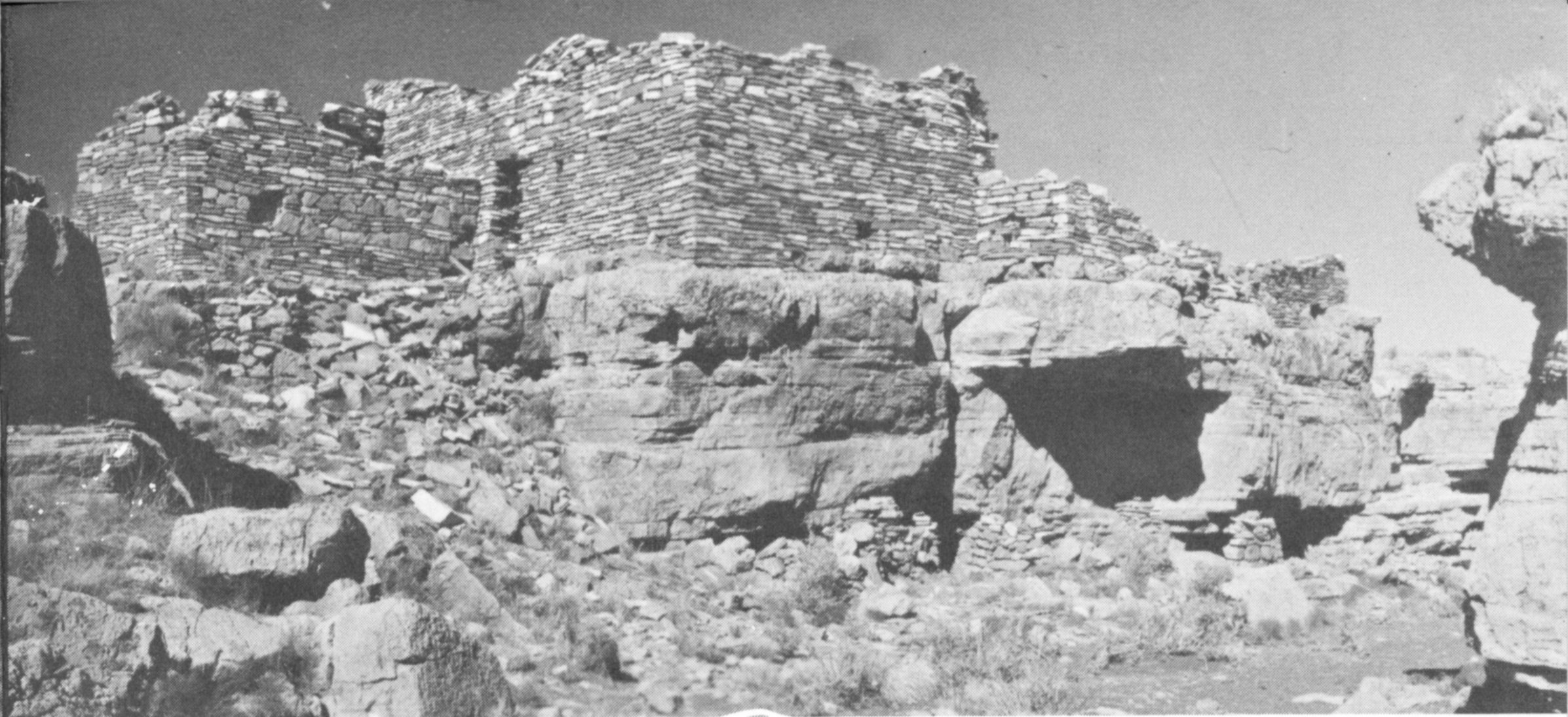
Lomaki Ruin
This region is one of the most interesting archeological and scenic localities in the United States. Sunset Crater National Monument is 18 miles (29km) south of Wupatki National Monument, and was the source of the black volcanic ash which had such profound effect on the prehistoric farmers. Twenty-one miles (34km) farther south is Walnut Canyon National Monument, a beautiful canyon and rim setting for hundreds of ruined homes of prehistoric Indians who also were influenced by Sunset Crater’s ash. Even farther south, in the Verde Valley, noted as Great Drought refugee areas, are Tuzigoot and Montezuma Castle National Monuments (the latter including Montezuma Well.)
If you are interested in the work of the National Park Service and in the cause of conservation in general, you can give active expression of this interest, and lend support by alining yourself with one of the numerous conservation organizations which act as spokesmen for those who wish our scenic heritage to be kept unimpaired for the enjoyment of future generations.
Names and addresses of conservation organizations may be obtained from the ranger.
This booklet is published in cooperation with the
National Park Service
by the
SOUTHWEST PARKS AND MONUMENTS ASSOCIATION
A non-profit publishing and distributing organization supporting historical, scientific and educational activities of the National Park Service.
We recommend the following items for additional information on the Southwest:
YOUR NATIONAL PARK SYSTEM IN THE SOUTHWEST, IN WORDS AND COLOR. Jackson. 500 word articles on each National Park Service area in the huge Southwest region, with full-color photograph for each of 66 areas listed. Highly authoritative treatment with every text checked for accuracy by National Park Service. Also contains “How to Get There” appendix. 76 pages, 69 full-color illustrations, color cover, paper.
ARCHEOLOGY ON THE SHONTO PLATEAU, NORTHEAST ARIZONA, Keith Anderson. 1969. Scholarly report on archeological salvage work in 1963-4 along the new road right-of-way between U.S. Highway 64 and Navajo National Monument headquarters. Includes appendix report on Bird Remains from Vicinity of Navajo National Monument, by Lyndon L. Hargrave, XII plus 68 pp., 2 maps, 14 tables, 10 line drawings, 21 half-tones.
100 DESERT WILDFLOWERS IN NATURAL COLOR. Dodge. Descriptions and full-color portraits of 100 of the most interesting desert wildflowers. Photographic hints. 64 pp., full-color cover, paper.
100 ROADSIDE WILDFLOWERS OF SOUTHWEST UPLANDS IN NATURAL COLOR. Dodge. Companion book to author’s 100 Desert Wildflowers in Natural Color, but for higher elevation flowers. 64 pages and full-color cover, paper.
FLOWERS OF THE SOUTHWEST DESERTS. Dodge and Janish. More than 140 of the most interesting and common desert plants beautifully drawn in 100 plates, with descriptive text. 112 pp., color cover, paper.
FLOWERS OF THE SOUTHWEST MESAS. Patraw and Janish. Companion volume to the Desert flowers booklet, but covering the plants of the plateau country of the Southwest. 112 pp., color cover, paper.
FLOWERS OF THE SOUTHWEST MOUNTAINS. Amberger and Janish. Descriptions and illustrations of plants and trees of the southern Rocky Mountains and other Southwestern ranges above 7,000 feet elevation. 112 pp., plus 4-color centerfold, color cover, paper.
MAMMALS OF THE SOUTHWEST DESERTS. Olin and Cannon. Handsome illustrations, full descriptions, and life habits of the 42 most interesting and common mammals of the lower desert country of the Southwest below the 4,500-foot elevation. 112 pp., 60 illustrations, 4-color centerfold of animal photos, color cover, paper.
MAMMALS OF SOUTHWEST MOUNTAINS AND MESAS. Olin and Bierly. Companion volume to Mammals of Southwest Deserts. Fully illustrated in exquisitely done line and scratchboard drawings, and written in Olin’s masterfully lucid style. Gives description, range, and life habits of the better known Southwestern mammals of the uplands. Color cover, paper or cloth.
POISONOUS DWELLERS OF THE DESERT. Dodge. Invaluable handbook for any person living in the desert. Tells the facts about dangerous insects, snakes, etc., giving treatment for bites and stings and dispels myths about harmless creatures mistakenly believed poisonous. 48 pp.

Write For Catalog
SOUTHWEST PARKS AND MONUMENTS ASSOCIATION
Box 1562—Globe, Arizona 85501
This eBook is for the use of anyone anywhere in the United States and most other parts of the world at no cost and with almost no restrictions whatsoever. You may copy it, give it away or re-use it under the terms of the Project Gutenberg License included with this eBook or online at www.gutenberg.org. If you are not located in the United States, you will have to check the laws of the country where you are located before using this eBook.